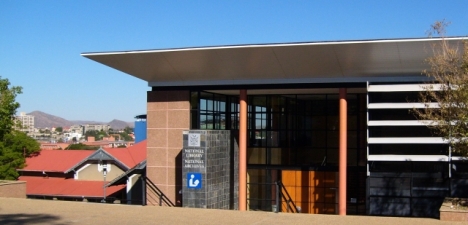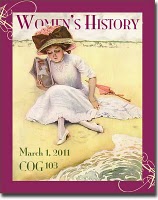Twenty years ago this month we went to Namibia on holiday, and one of the reasons we wanted to go was to learn more about Fred Green, Val’s great great grandfather, who was a trader and elephant hunter there for about 25 years, from about 1850 until his death in 1876.
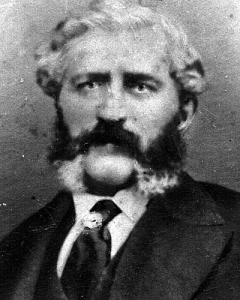
Frederick Thomas Green (1829-1876) Born Montreal, Quebec. Died Heikhamkab, near Walvis Bay
We’ve been scanning some old photos, including photos of that holiday trip, and so it seemed a good time to share them and some of the related family history, old and new. Val had been to Namibia a year before, about a week after it became independent, and spent some time in the archives looking up the history of the Green family, and meeting some relatives and other researchers, like Dag Henrichsen, from Switzerland, who was particularly interested in Fred Green’s eldest daughter, Ada Maria Green, known as Kaera. Val also met a cousin, a descendant of Kaera, Mburumba Kerina, who is credited with the invention of the name Namibia.
In April 1991, however we all went, driving via Upington and the Augrabies Falls on Bright Monday, spending a night in Karasburg, and reaching Windhoek the next day. It was the first time I had been back to Namibia since being deported nearly twenty years before. It was interesting to see how things had changed in twenty years, and especially since independence. Some friends in Windhoek said that the biggest change had taken place overnight — the moment that the South African army withdrew to south of the border the whole country breathed a sign of relief and peace descended. There were several new buildings in Windhoek, which seemed somehow brighter and more cheerful.
We went north to stay ar Gross Barmen, and from there visited Okahandja, Omaruru and Otjimbingwe, places that Fred Green knew well 130 years before. You can read more about Fred Green’s life and times here and here.
8-Apr-1991, Monday
Abstract
Bright Monday. Leave for Namibia. Visit Kuruman, Aughrabies Falls, stay in Karasburg
Left for Namibia at 03:30, and travelled down the freeway to Muldersdrift, then through Tarlton and Ventersdorp. It began to get light then, and between Ventersdorp and Coligny for quite a long way there were road works and deviations. At Biesiesvlei Val took over driving, and we stopped for breakfast in Vryburg at a restaurant that served a “Kalahari breakfast” of eggs, wors, bacon and chips. We reached Kuruman at about 11:00 and had a look at the eye, and the fish in the pool next to it, and filled up with petrol.
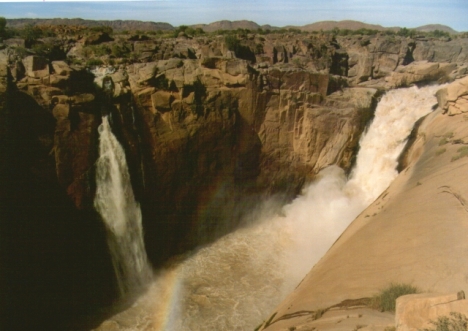
Augrabies Falls, on Orange River below Upington
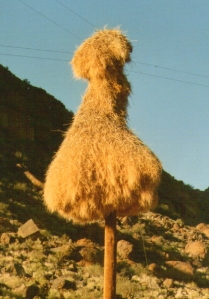
Social weavers' nest on a telephone pole
We reached Upington about 14:00, and bought Kentucky fried chicken for lunch, then drove on to Keimoes where we filled up with petrol, and reached the Aughrabies falls at 15:00, and spent about an hour there wandering around and looking at the falls from various viewpoints. Simon found a colony of dassies. We drove west across a flat plain, and contemplated going to Pofadder and possibly sleeping there. I’d always wanted to see Pofadder, because of the name, and it seemed the most isolated place in South Africa, but the scenery looked boring, and so we decided rather to go to Karasburg via Onseepkans, and it was a scenic drive down to the Orange river with the sun beginning to go down, social weaver nests on the telephone poles, and groves of kokerbome on the hills, and one next to the road that we stopped to photograph.

Kokerbome (Quiver trees), found in Northern Cape and southern Namibia
At the border there was a square army tent with a black guy and a white guy in camouflage uniform, looking bored. They stamped our passports, and we crossed the river. It was quite wide there, flowing slowly through pools and reeds – nothing like the roaring rush of water through the gorge upstream at Aughrabies. On the Namibian side there was an identical tent, but the immigration/police officers smartly dressed in navy blue trousers and white shirts. One was reading an English novel with the help of a dictionary – with the official language being English now, a lot of people will have to learn it.
We drove into the setting sun towards Karasburg, and arrived there at 19:00. We asked for a room at the Kalkfontein Hotel, and they guy there offered us his “five-star” room, with six beds, and air-conditioner and a bathroom and shower for the all-in price of R175-00 – not bad for these days. We went straight to dinner – mutton stew and vegetables – and then straight to bed. It had been a long day of driving.
9-Apr-1991, Tuesday
Abstract
Karasburg to Windhoek. Supper with Enid Ellis
We woke up about 06:50, and had breakfast at the hotel – similar to what we had had yesterday, wors, eggs, bacon and chips. They had stickers from UNTAG and the Australian Army, relics of the transitional period last year. The atmosphere seemed relaxed and friendly. in marked contrast to what it had been when I left nearly twenty years ago. We left just after 08:00, and drove to Grunau, where we stopped for petrol at the Shell garage just north of the village. There was a shop in the garage with an amazing range of merchandise on sale, and a sign on the door that said “Come in” in English, Afrikaans and Kwanyama – the last seemed rather strange this far south. We bought a map and some postcards, and on the way to Keetmanshoop I wrote postcards to Joy Bidgood, Marios and Kia Prelorenzo. We took photos of the Karasberge – I had been through them many times, mainly at sunrise or sunset, but had never really taken pictures of them, and they were always to me the real sign of entering or leaving Namibia, even though they are about 200 km from the border.
At Keetmanshoop we bought a lot of stamps. Some cars had new number plates, with an N, followed by the number, and then a K, instead of the old SK ones. Others had green numberplates with GRN on, which I assumed stood for “Government of the Republic of Namibia” in place of the old A…G numbers. As we went north from there Val and the children stuck stamps on to the “Blue Press” that we were sending out. There was one section where they were working on the road, and we had about 15 km of gravel detour, with great clouds of dust. There were many heavy trucks on the road – far more than I remember from twenty years ago. Mukurob, the finger rock, which used to be visible from the road, was also gone – it had fallen down a couple of years ago.
We stopped at Mariental for hamburgers – real ones this time. There were many more cafes and shops selling food. Last time I had stopped at a cafe the menu had “Rice – or something else” and a “hamburger” consisted of very greasy mince on toast. Now they had some quite good ones. We posted some of the Blue Presses, and pushed on to Windhoek. Rehoboth, too, seemed much developed. There were street lights on the main road, and many more prosperous-looking houses. We reached the Auas mountains about 15:30, and stopped to look over Windhoek and take some photos, and when we started again the car battery light came on. We called at a garage at the bottom of the hill, and found that it was just that the ignition lock had been in the wrong position.
We drove into town, getting lost because of the new bypass roads a couple of times, and went to the post office, and posted the Blue Press for people within Namibia. We then went to Klein Windhoek, past 41 Klein Windhoek Road, where I had lived 20 years ago, and called on Val’s cousin Enid Ellis, and stayed for supper with them. Enid’s husband Justin was away at a conference. We saw their son Hugh, now aged 12, for the first time since he was three months old, and their daughter Bronwen, aged 7, for the first time ever. Bronwen was embarrassed because she had been to the beach at Swakopmund, and had been bitten by sandfleas, and was all over itchy bites.
I phoned Dave de Beer, who was staying at the Safari motel, and had said he would be here accompanying a group of European parliamentarians on a tour of Namibia. He wasn’t available, but I left a message for him to phone me back, and soon afterwards he did. He said we should go to see him about lunch time tomorrow at the hotel, as, though he would later be going to Johannesburg, we thought it
would be good to meet again on Namibian soil. Enid said that locally people spoke of the GRN number plate vehicles as standing for “Go Round Namibia”.After supper we drove to the Daan Viljoen Park on the Khomas Hochland road, and slept in a couple of huts there.
10-Apr-1991, Wednesday
Abstract
Spend morning in Windhoek archives, lunch with Dave de Beer. Enid Ellis & her children come to have a braai with us at Daan Viljoen Park
We went in to Windhoek in the morning, and parked in a parking ground opposite the Zoo Gardens, and went in to Wecke and Voigts, where I had bought a hat once. I looked for another hat like the one I had lost in Swaziland, but they only had JB Stetson Texan-style hats that would have been OK if it hadn’t been for the TV character J.R. Ewing. But in a shop next door they had some nice hats. A little further down the road there was a new pedestrian mall that went over Stuebelstrasse, and was very pleasant. We stopped at a kiosk there for some ham and salami brotchens for breakfast, and a guy came up and said he was hungry, and we gave him some money and he promptly bought chips and all the most bulky things he could get. We left the children looking at shops for stickers and T shirts and things, and went to the archives, where we saw Brigitte Lau, and told her about our project for transcribing Ada Leinhos’s case against the South West Africa Company. She said we had given so much stuff to the archives that she would give us a free copy of the German war map, which showed Frederick Vincent Green’s birthplace of Ehangero, on the Omuramba Wamatako, about 20km west of the present Okahandja-Otjiwarongo road. We looked up a few other things, and photocopied some missing pages from the court case.
Then we went to the Safari Motel to wait for Dave de Beer, whose conference was finishing. We had lunch at the Safari Motel with Dave, who told us something of what he had been doing. He had visited Gobabis with his parliamentarians, and they had stayed at the hotel there, and seen the jail. They had also visited Epukiro, where chief Munyuku was cooperating with the establishment of community farms. Dave said they were particularly concerned about health services, and that the nurses said that there was a lot of high blood pressure among Hereros, presumably because of all the milk and meat they eat. He said that in Ovamboland the traditional healers were cooperating with the health services, but when he asked about it in Hereroland, people were very cagey, though he had no idea why that should be so. He also said that Mburumba Kerina had been kicked out of parliament – I hadn’t known that he was in, but apparently he had represented a small coalition of his own group and the Rehoboth Basters, and Sam Nujoma had taken him and some of the other original petitioners to the United Nations along with him when he went there to apply for membership of the UN, even though they were now political rivals. This had led to Mburumba Kerina and Sam Nujoma being reconciled, and Mburumba joined SWAPO, so his original group obviously no longer wanted him as their representative. He said Assaria Kamburona was very active politically in the DTA, and that political differences had split the Oruuano Church, though he didn’t seem to have much evidence for that. Hiskia Uanivi is still, apparently, active in his Communist Party. While we were talking, Zephania Kameeta walked by, and said we could see him tomorrow at the Lutheran Church offices, where he is staying in a guest room.
We took Dave to the Anglican cathedral, and looked for Roger Key in the deanery, but he was out, so Val took some pictures of us together up by the bell, and we took some photos of the whole family there. We went down to the diocesan office, now in Fr Willie van der Sijde’s old house, and spoke to the diocesan secretary, who said that the diocese was chronically short of money and didn’t have enough to pay clergy stipends – though it was in the pockets of the people. It reminded me of the day I arrived [in 1969], when Dave himself was diocesan secretary, and he had R95.00 in the account and had to pay stipends the following week. We gave a calendar to Dinah Handura’s daughter, who worked in the office. Dinah had cleaned our house in Klein Windhoek.
Then we took Dave to the centre of town, and went to the OK Bazaars (another innovation since I was last here) and bought some ingredients for a braai tonight, and went back to the Daan Viljoen Park to prepare it. Enid, Hugh and Bronwen joined us about 16:30, and after walking around the dam we had a braai – except for Bronwen, who is vegetarian, and we chatted about old times, and caught up on the news of what we had been doing since we had last met 12 years ago, when we were in Melmoth and Enid was about to leave for England. The children all played soccer, and seemed to get on well together.
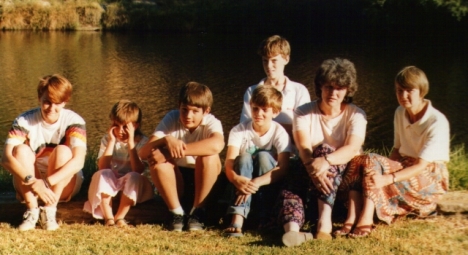
Bridget Hayes, Bronwen Ellis, Hugh Ellis, Jethro Hayes, Simon Hayes, Val Hayes, Enid Ellis at Daan Viljoen Park, Khomas Hochland, Namibia
11-Apr-1991, Thursday
Abstract
Visit Zephania Kameeta, stay at Gross Barmen
We drove around the Daan Viljoen Park before leaving, and saw several animals – jackals, tsessebe, kudus and wildebeest. We again went to town and had brotchens for breakfast, then went to see Zephania Kameeta. He said he and his wife had bought a house in Mariental, as she originally came from there, and houses were much cheaper. Their white neighbours were very right-wing, and it was a new experience for them to have blacks living next door. Zephania said that cabinet ministers were civil servants, and so got housing allowances, but on an MP’s salary he could not afford a house in Windhoek. We remarked on the relaxed and peaceful atmosphere in the place, and he said that it had originally seemed strange to think that they could cooperate with some of the right-wing political groups like ACN, but that when they did so, things seemed to work well. Zephania said he had done research into his own family history from the church registers in Otjimbingwe, where he himself had been born, and said we should go there and ask the Pastor, Pastor Mujoro, if we could look at the early registers, which should still be there.
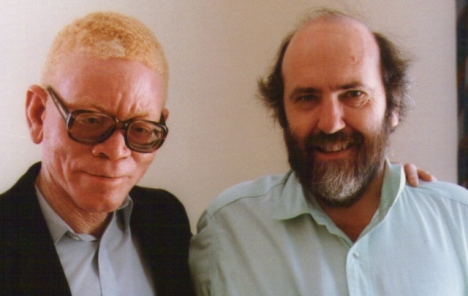
Zephania Kameeta & Steve Hayes. Windhoek 11 April 1991
We left Windhoek then, and drove around Katutura for a while, and stopped to take photos of the graffiti on the Ovambo compound, which were colourful, and wondered what the compound was used for now. There was a new four-lane highway as far as Brakwater. At Okahandja we drove around for a while looking for Maharero’s grave – it was far more hidden away than I remembered it, and then went on to the resort at Gross Barmen, where we stayed in a marvellous flat, complete with air conditioning, chairs and tables, and we relaxed for the rest of the afternoon and in the evening went swimming before having dinner at the restaurant, and we chatted to the waiter who was Kwanyama, and knew Nehemiah Hamupembe and some of the Anglican clergy at Odibo.
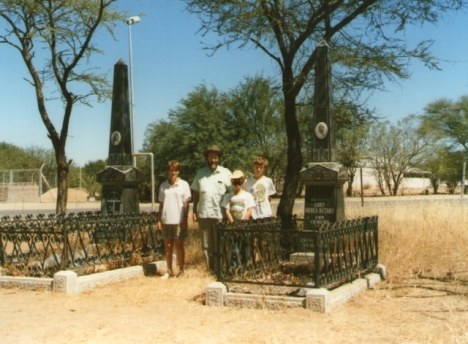
The graves of Herero heroes at Okahandja: Clemens Kapuuo and Hosea Kutako
12-Apr-1991, Friday
Abstract
Visit Omaruru, drive round Erongo mountains to Otjimbingue
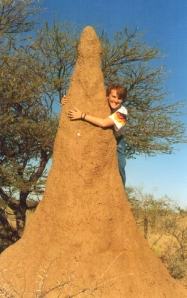
Anthill between Gross Barmen & Wilhelmstal
We were up early, and drove along the back road to Wilhelmstal, where I had gone when I worked for the department of water affairs. We saw lots of game – jackals, kudu and gemsbok – all along the road. We then went to Omaruru, which was much more green and pleasant than I remembered it. We stopped at a small cafe for breakfast – again our ham and salami brotchens – and handed out St Nicholas Calendars to everyone we met. We went to the municipal offices where there was a sign advertising tourist information, and spoke to a Mr Bester, a former policeman who had come here from South Africa in 1964, and stayed on when he left the police force. He told us about some of the tourist attractions in the area, and we bought a couple of booklets as well. He showed us some maps, and some reports of a geological survey done by people from Rhodes University a few years ago – they said that the nearby Erongo mountains were the largest volcanic formation in the Southern hemisphere.
We drove through the Erongo mountains, wishing we had more time to spend here and explore. I remembered one, in particular, that looked like an enormous lizard, and when I passed in when working at the Department of Water Affairs it had seemed as though this was the end of the world. Knowing the country beyond it, it now seemed much more tame. We drove south past the western edge of the mountains, stopping to take photos of the Erongo and Spitsberg. I had once travelled along this road when the sun was setting over the Spitsberg and the moon rising over the Erongo, and it had been spectacularly beautiful. But even in the middle of the day there was a grandeur to it. We stopped for cold drinks at Usakos, but most of the shops were shut for the afternoon siesta. We went on to Karibib, where I wanted to take pictures of the old hotel, but it had vanished, and someone said it had been demolished 16 years ago, which was sad, because it had been the most interesting building in the town.
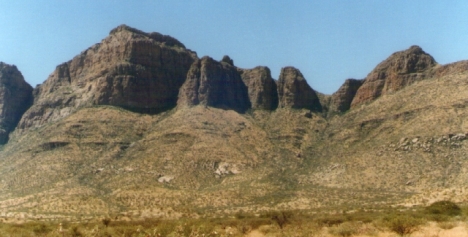
The Erongo mountains in west-central Namibia -- country that would have veen familiar to Fred Green
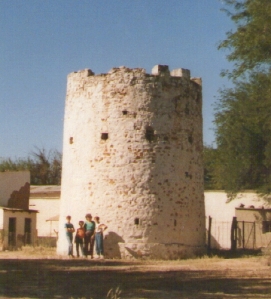
Powder tower at Otjimbingue, said to have been built by Fred Green
We went down to Otjimbingue, and looked for pastor Mujoro, and found there were two pastors – a husband and wife, but the wife was out at the church council, and the husband was asleep and apparently not to be disturbed, so we did not get to see the church registers, but took photos of the powder tower, allegedly built by Fred Green in the 1870s. As we were leaving Otjimbingue, the exhaust pipe fell off, but we were able to tie it up with a bit of wire, and got back to Gross Barmen roaring like a ferry.
13-Apr-1991, Saturday
Abstract
Gross Barmen to Ai Ais. See Roger Key, but not Mburumba Kerina
My 50th birthday. We packed up at Gross Barmen, and drove in to Windhoek, went straight to a garage called Auto-Fit, where they repaired the exhaust pipe, and then once again parked at the Zoo Gardens parking ground, and got brotchens from Wecke and Voigts for breakfast, and then went round to Kerina’s office in Kenya House in Leutweinstrasse (he’d said the street name had been changed to Mugabe Avenue, but all the old signs were still up) – it took us some time to find it. He had said it was the former Grand Hotel, but only when we got there did my memory of it come back – I’d met some journalists there from the Argus Africa News Service once. But Kerina was not in. A guy at the reception counter was rather cynical – Kerina had said he would meet us at 09:30, and the guy said that meant he wouldn’t be in before 10:00.

Jethro, Bridget, Steve & Simon Hayes: at Zoo Park above Independence Avenue, Windhoek. 13 April 1991, Steve's 50th birthday
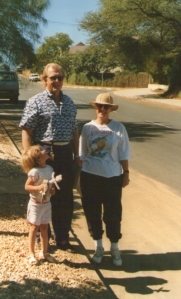
Roger & Shaunie Key
We went to see Roger and Shaunie Key at the Anglican Deanery, and chatted to them for a while, and Roger got me to sign the Cathedral visitor’s books. He said he’d been very surprised to receive the Blue Press we had sent him [it was Roger who told us how peace descended on the country when the South African army left]. We made another attempt to see Kerina, but he was still not there, so we left Windhoek, driving south to Ai Ais. We turned off the main road at Kalkrand, and went towards Maltahohe, reaching it at about 14:00, and filled up with petrol there. The town seemed absolutely dead. We drove on to Helmeringhausen across the flat and dusty plain, with the iron-red plateau range on the left. Helmeringhausen too was dead on a Saturday afternoon, a little hamlet with stone houses that looked as if it hadn’t changed for 80 years.
We drove on to Bethanien, and took some photos on the way, and stopped at Bethanien for petrol, and then drove on to Ai Ais as the sun was setting, seeing the Karasberge from the west this time, looking very different. It was dark by the time we got to Ai Ais, and we only just made it to the restaurant before they closed.
14-Apr-1991, Sunday
Abstract
Ai Ais to Olifantshoek
After breakfast we walked around for a while, looking at the Fish River canyon, and bought a few things at the shop, and then drove back north along the road we had come down in the dark last night, and went to the view point on the Fish River Canyon and took photos from there. We then drove to Grunau, and bought hamburgers and wors rolls for lunch. We debated going south via Vioolsdrift, Springbok and Pofadder, but decided that it was too late for that, and took the direct route through Karasburg and Ariamsvlei.
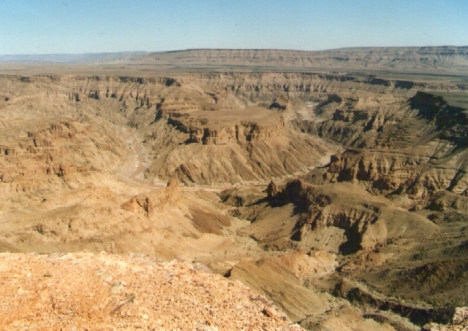
Fish River Canyon
We passed the Namibian border control post just past Ariamsvlei, quite a way before the actual border. Though it was a prefab building it looked quite smart, with the flag flying, and immigration officers who were polite and efficient. About twenty km on we came to the South African “monitoring post” – a khaki tent, no flag, and an enormous Casspir armoured car parked outside. There were three scruffy looking characters in camouflage uniform sitting at a folding table covered with cold drink cans – one to write down the information in the passports, the second to stamp the passports, and the third to read the picture story book. It could hardly have been a greater contrast.
I’d bought a copy of the Sunday newspaper “Rapport” in Grunau, and we were back to the reports of violence. Virtually nothing was said about any news in Namibia at all. We filled up with petrol in Upington, and set off for Kuruman as quickly as possible, as the car lights weren’t working properly, but by sunset we had only reached Olifantshoek, so we booked in at the hotel there. It was very pleasant. We had a good supper, and it was cheaper than Karasburg. We celebrated with a bottle of 5th Avenue Cold Duck, and when we popped the cork it hit the ceiling and squashed a mosquito there.
15-Apr-1991, Monday
Abstract
Returned home – someone had broken into the house
We left Olifantshoek after breakfast, and drove through Kuruman, Vryburg (where we stopped to get a couple of new tyres),
Biesiesvlei and Ventersdorp. We got home about 16:30, and there was a policeman there guarding the house. someone had broken in sometime, and broken seven window panes, but they appeared to have been disturbed, as apparently everything they had taken was at the police station. Marios came round, and said he thought the break-in was last night, as he had come to check the place and found all the lights on.
End of diary extracts
Much of the country we passed through on this trip would have been familiar to Fred Green, his wife Catherine Stewardson (who was born at Rooibank, near Walvis Bay) and their older children — Mary, who was born in Ovamboland, and Fred junior (Val’s great grandfather) who was born somewhere east of Omaruru.The graves of the Herero heroes took on a new significance when we discovered that Fred Green and Samuel Maharero had been firends (though they had also fought), and Samuel Maharero made a grant of land to Fred Green’s daughter Ada when the Germans were beginning to colonise the country. The Germans tried to give her land to a commercial company, but she took them on in court, and won. When the South Africans invaded in 1915, she had to fight the battle all over again, and won a second time, and she then lost it all when she stood surety for her no-good son-in-law.
When we started our family history research in 1974 we didn’t have a clue about the Namibian (or Canadian) connections of the Green family, and we only learnt them when we made contact with Val’s great aunt Gladys Clark, so this trip enabled us to look at things with new eyes.
Filed under: family history, genealogical research, genealogy, Green family, Greene family | Tagged: Erongo mountains, family history, Fred Green, genealogy, Green family, Herero history, history, Namibia, Otjimbingue, Stewardson family | 3 Comments »
 Werner Hillebrecht, the archivist, was very helpful, and suggested several published sources that might be able to help — some journals of Swedes in Namibia, including Axel Wilhelm Eriksson, have been translated and published in English.
Werner Hillebrecht, the archivist, was very helpful, and suggested several published sources that might be able to help — some journals of Swedes in Namibia, including Axel Wilhelm Eriksson, have been translated and published in English.






